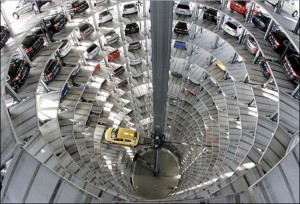
You won't find Mickey Mouse at the Volkswagen theme park AutoStadt, but there are plenty of Beetles - and a glass-walled new car delivery center.
It’s become one of Europe’s most popular – if unlikely – theme parks, drawing visitors from all across the continent. Entire families take the day off, calling in sick from work and sending excuses off to school. But if you’re expecting to find Mickey Mouse at the AutoStadt theme park, forget it.
The name, in German, means “auto city,” an appropriate nickname for Wolfsburg, itself, the town that grew up around Volkswagen and serves as the automaker’s headquarters. Less than a two-hour drive from Berlin, alongside the old East/West German border, Wolfsburg is the ultimate company town.
But until a decade ago, it wasn’t much of a tourist destination. Then, AutoStadt was opened to coincide with the nearby Hanover World’s Fair – and Volkswagen’s big push to transform itself from an automotive also-ran into one of the industry’s largest manufacturers.
The idea of an automotive theme park was mocked by skeptics, and there were plenty of reasons to dismiss its chances. In Flint, Michigan, birthplace of General Motors, a similar concept, dubbed Auto World, failed miserably, losing investors – and the struggling city – millions of dollars. But as with those who bet VW itself was going to fail, AutoStadt has turned into an unexpected hit.
It helps that Germans have a particular love of technology. Even housefraus can talk horsepower and torque. So the visitors have been coming in steady streams – more than 2 million a year, 19 million in all since AutoStadt opened. The company quotes statistics claiming Autostadt is now Germany’s second most popular theme park, generating enough revenues to cover most of its operating costs, though VW does pump some money into the venture, which it gladly writes off as a marketing expense.
This definitely isn’t Euro Disney, no roller coasters and Ferris wheels, or giant mice posing for pictures with the kids. But if you’re into cars, you’ve come to the right place.
While many visitors drive up the A2 Autobahn, a surprising number reach AutoStadt via Germany’s efficient high-speed rail network, visitors entering the theme park through a massive piazza, its giant glass walls computer-controlled to automatically swing open or shut according to the weather and time of day. As they enter, visitors stride under a giant aluminum globe, a theme echoed below them. A large portion of the piazza’s flood is transparent, revealing a cluster of 64 globes, each touching on a political, social or environmental theme.
Indeed, the park has taken on an increasingly green hue since it first opened, more than nine years ago, reflecting both the German focus on the environment and the auto industry’s effort to appear part of the solution, rather than the problem.
But at an initial cost of $450 million, one shouldn’t expect AutoStadt to be an entirely altruistic and high-minded venture. The park is designed to celebrate the auto industry, VW in particular, and to sell cars.
The AutoStadt museum traces the evolution of the automobile, from the first, crude horseless carriages to today’s 200-mph supercars. Even the competition has a place – albeit small – in the exhibition, with the occasional Mercedes-Benz, Cadillac and even a Messerschmidt, the bizarre little 2-seater that helped revive Germany’s auto industry in the rubble of World War II.
As one might expect, the Beetle has a special place of honor in the museum, with several early prototypes on display, as well as a rhinestone-covered model, the 1 millionth to roll off the assembly line.
While the automaker is currently moving forward on the development of an all-new remake of the Beetle, Volkswagen has evolved dramatically since the days when a British colonel was assigned to see if the bombed-out factory could be restarted, in the wake of the War. Today, Volkswagen AG operates 9 separate brands, and will add a 10th when it completes a takeover of Porsche in 2011.
Those various marques, Audi, Bentley and Lamborghini – have their own buildings, each delivering the brand message. The Lambo exhibit is one of the most popular attractions. Every few minutes, a large circular door revolves in a puff of smoke, revealing the company’s newest products.
Autostadt sits alongside the heart of the Volkswagen empire, the old Halle 54 assembly plant, which visitors can tour by tram. Each day, the factory turns out roughly 1,000 vehicles, and a surprising number of them are diverted to one of the theme park’s central landmarks, a glass-walled twin-tower delivery center where an average 600 visitors a day come to take the keys to their new vehicle. Free admission to the theme park is part of the special delivery package.
Like any good theme park, there are plenty of trinkets for sale; there are numerous restaurants which, in recognition of the melding world, includes a Japanese noodle shop, and even a new Ritz-Carlton hotel. The factory’s old power plant has been converted to a hip nightclub, which attracts big-name talent and young clubbers from Berlin and other cities. Meanwhile, the new sports arena has given Wolfsburg its first-ever competitive soccer team.
Surprisingly, the number of visitors to AutoStadt from outside Germany continues to grow, some even coming from North America and Asia. To keep things fresh, VW has been updating most of the exhibits at least every other year.
What’s particularly surprising is that the number of visitors has remained strong, despite the weak economy and the virtually collapse of the global automotive market. So, despite the fact that there’s a Beetle, rather than a Mickey Mouse, AutoStadt continues to confound the skeptics
